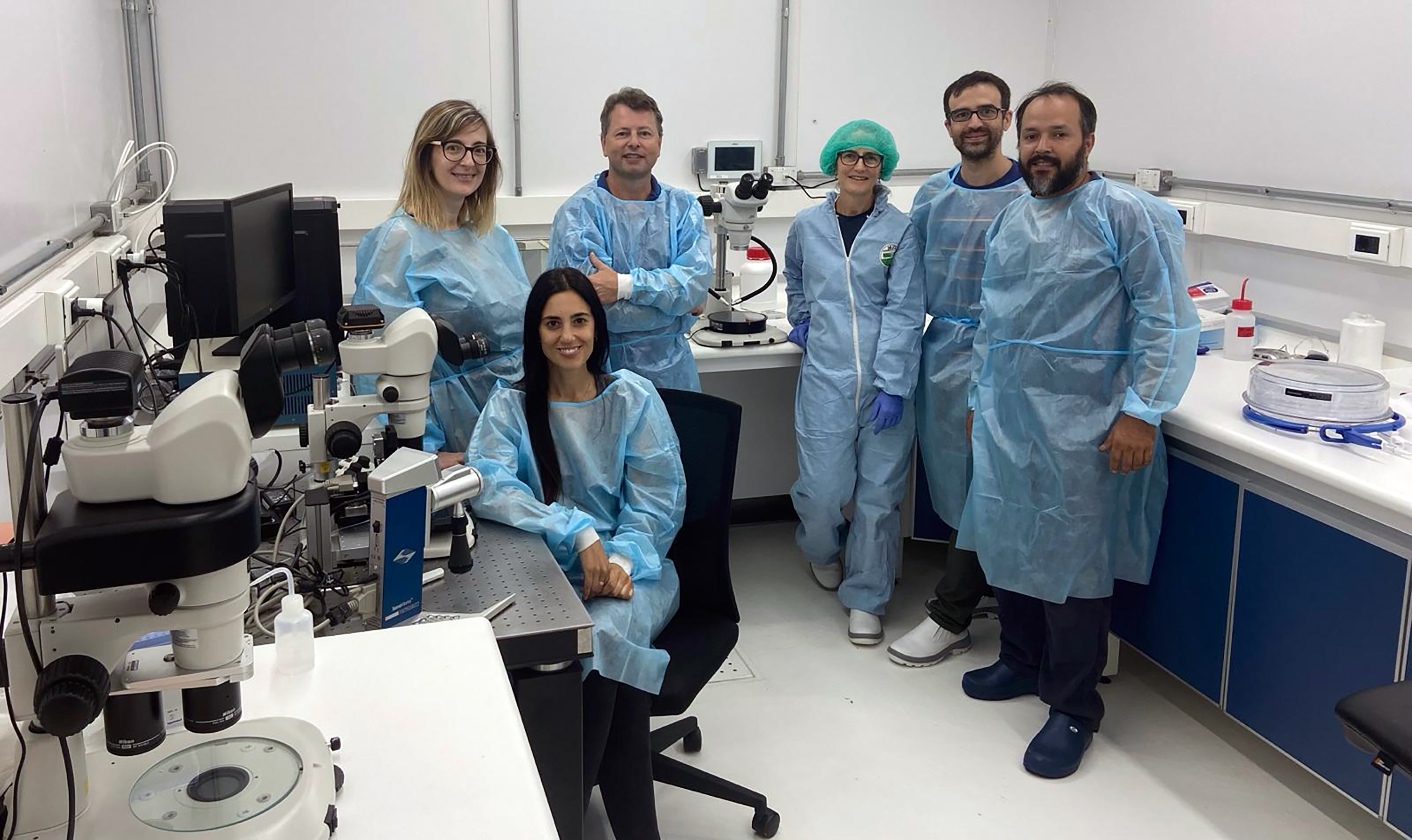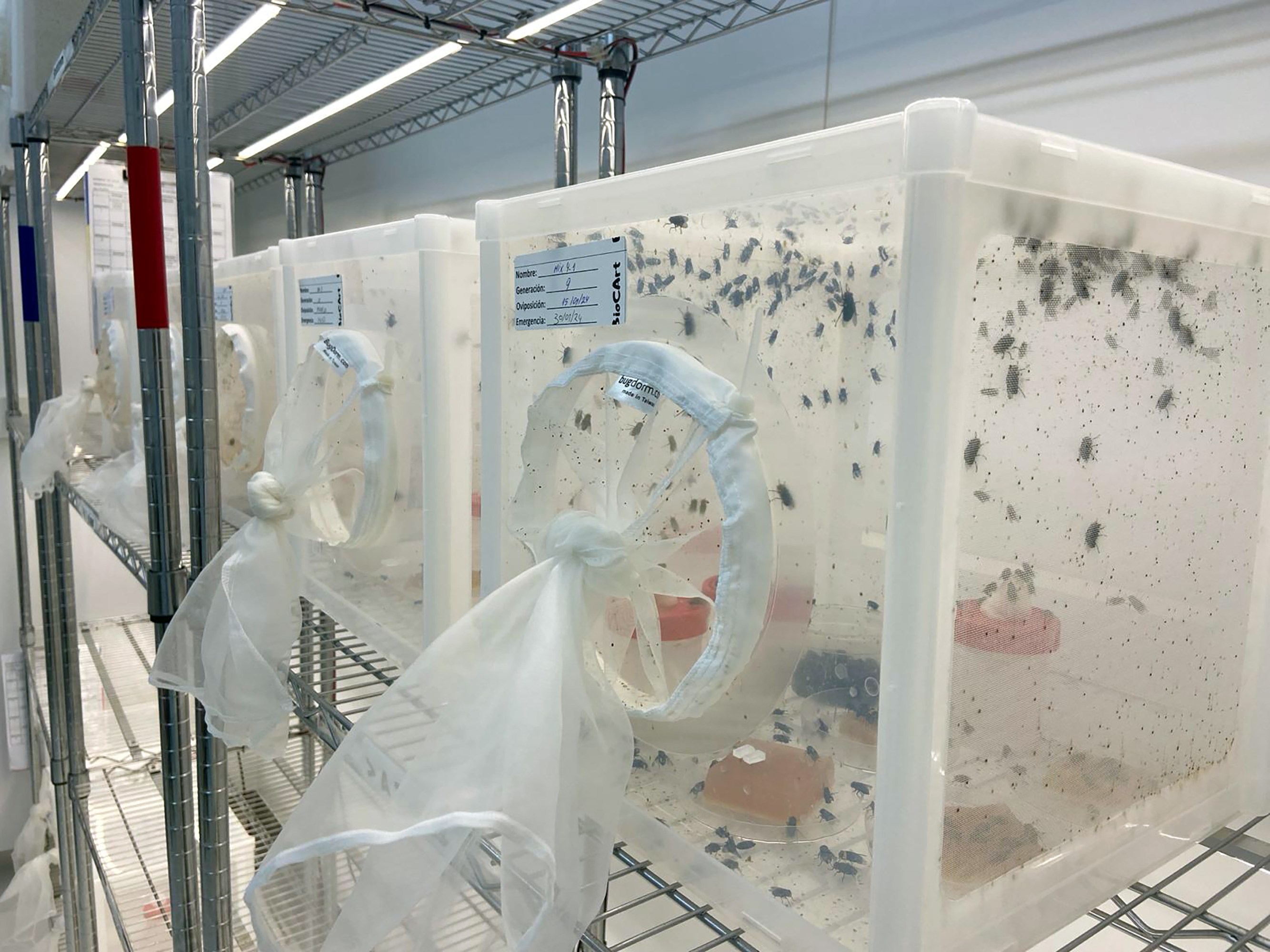Uruguay wants to use gene drives to eradicate devastating screwworms
A hereditary defect created with CRISPR could wipe out cattle-killing pests that cost the country millions.

On a warm, sunny day in Montevideo, Uruguay, the air is smogless and crisp. Inside a highly secured facility at the National Institute of Agricultural Research (INIA) are a sophisticated gene gun, giant microscopes, and tens of thousands of gene-edited flies, their bright blue wings fluttering against the walls of their small, white, netted cages.
These flies—shown to me on video by an INIA veterinarian, Alejo Menchaca—are a new weapon that may soon be unleashed against an enemy that kills cattle and costs the livestock industry millions of dollars every year: the New World screwworm, a parasite common in parts of South America and the Caribbean.
When a female screwworm fly attacks cattle, it lays eggs, which hatch and turn into worm-like larvae that screw down into the host animal, feeding on flesh along their way and damaging the animal’s skin. Left untreated, the animals eventually die in excruciating agony.
But Menchaca and colleagues have a plan. Using the genome-editing system CRISPR, they’ve developed what’s known as a gene drive, a type of genetic element that manipulates the reproductive process to spread farther and faster than an ordinary gene. They are about to move into the next stage of caged trials in the lab, with a view to eventually using the genetic tool to decimate the screwworm fly population. In collaboration with Institut Pasteur de Montevideo, they have received a $450,000 grant from the Inter-American Development Bank (IDB) for the research.
“With gene drives, we can control these pests in precise and effective ways,” says Menchaca.

Gene drives occur naturally in the wild, but the technology for making them deliberately is new and still pretty controversial. CRISPR allows scientists to cut specific genes in any organism’s DNA and replace them with new sequences. It can be used to tweak an animal’s DNA in a way that affects the species’ survival, often by making the females sterile, when it spreads in the population through breeding.
Some organizations have been trying to develop gene drives to eradicate mosquitoes. Target Malaria, supported by the Seattle-based Bill & Melinda Gates Foundation (BMGF), is currently the most advanced gene-drive project in the world. But even then, they have never gone beyond caged trials. The process of getting permission for field release efforts has crawled.
In 2020, the INIA researchers received permission from the Uruguayan government to test their techniques through the country’s existing National Program for Control of Screwworms. Right now, they’re experimenting with different components of the gene drive in gene-edited screwworm flies in the lab. The plan is to create a population of male screwworms with edited versions of genes that are essential for fertility in the female screwworms. When the engineered males are released into the wild, they should mate with females and pass on that gene.
Over successive generations, more and more female screwworms will inherit copies of the gene drive and become sterile, causing a population crash.
“The thing that's attractive is if you knock a gene drive into the female, you could disrupt female development,” says Maxwell Scott, an entomologist at North Carolina State University who is working with the Uruguayan team. “It’s potentially a very efficient system.”
The situation is urgent. In July of last year, Panama declared a state of animal health emergency amid outbreaks of cattle screwworm throughout the country. And this February, more than 200 cases of screwworm attacks on animals were reported in Costa Rica, prompting the government to declare an emergency as well. In Uruguay, screwworm flies cost the livestock industry $40 million to $154 million a year. Agricultural export is the linchpin of Uruguay’s economy—over 80% of the goods the nation exports are agricultural products. Beef, which accounts for 20% of that, is worth $2.5 billion a year.
That makes the country’s search for new tools to combat the pests even more critical, says Carmine Paolo De Salvo, a rural development expert at the IDB. “The [Uruguayan] government is under constant pressure to do something about it,” he says.
Scientists have been trying to tackle screwworms for decades. One method, known as the sterile insect technique (SIT), was developed by researchers at the US Department of Agriculture in the 1950s. SIT involves sterilizing male screwworm flies with radiation. Then, using airplanes, the DNA-damaged males are dropped on the area of infestation. When they mate with wild female flies, the eggs that are produced do not hatch, slowing population growth and preventing the spread of the parasite.
That approach has worked in many countries, including parts of Central America, freeing livestock and wildlife by the millions from the painful grip of the pests. In the US, an area-wide eradication program using SIT worked so well that in 1966, the USDA declared screwworm eradicated within the nation’s borders. The benefits to the livestock industry were immense: producers saved up to $900 million, and the health of both wild and farm animals improved.
Even with sterile males, eradicating screwworms remains a stubborn challenge, however. To prevent the screwworms from returning, the US—along with Central and South American countries—still runs a permanent barrier zone of sterile flies on the Panama-Colombia border, requiring a continuous supply of billions of flies every year. This effort is too expensive, and it’s simply not powerful enough to eradicate screwworm in South America, where the pests are firmly established and difficult to surveil, researchers say. So the search has been on for alternative tools.

It was Kevin Esvelt, a pioneering leader in CRISPR gene-drive systems, who first turned the team on to the idea of using one. Esvelt had been experimenting with engineering localized versions of gene drives to target Lyme disease in the US when he met the team of Uruguayan researchers on a tour of the MIT Media Lab. Shortly after that meeting, Esvelt was on a plane to Uruguay, where he met Menchaca and convinced Uruguayan officials to initiate a gene drive project to eradicate screwworms. This would have the advantage over SIT because while SIT reduces the number of successful births, the infertility conferred by the gene drive passes through multiple generations.
The team is looking to use an approach that Scott has successfully developed for livestock pests. In a recent study, Scott and his team tested it on the spotted-wing drosophila, an invasive fly that attacks soft-skinned fruit. The gene drive they developed for that study carried an edited version of the so-called doublesex gene, which is essential for the fly’s reproduction. In caged trials, they combined the engineered fly population with a population that didn’t have the gene edits, mimicking a real-world release. They found that the gene drive was copied at a rate of 94% to 99%—beyond the efficiency they had expected. “It was the first really efficient-homing gene drive for suppression of an agricultural pest,” says Scott. He hopes that a similar technique will work with screwworms and allow researchers to perform safer tests.
It won’t be a quick process. Assembling the gene-drive system, testing it, and securing approvals for field release could take many years, says Jackson Champer, a researcher at Peking University in Beijing, who is not part of the Uruguayan team. “It’s not an easy task; there have been many failed attempts at gene drives.”
Menchaca agrees. He says he and his colleagues aim to integrate their system into the flies and validate the technology in two to three years, adding that they hope to seek permission for field testing and will consider inviting companies to participate in scaling up the technology in the future.
However, Esvelt hopes the Uruguayan researchers will one day be able to release and test their altered screwworms in the wild. He believes that Uruguay’s robust regulatory environment makes the country a likely site for such experiments.
“This would be a project run effectively by Uruguayans, for the benefit of Uruguay, and may be offered eventually—if it works well—to a broader array of folks throughout South America,” he says.
Update 28 February 2024: An earlier version of this article did not mention Institut Pasteur de Montevideo. In fact, Institut Pasteur de Montevideo is an equal partner with INIA in this project.
Deep Dive
Biotechnology and health
How scientists traced a mysterious covid case back to six toilets
When wastewater surveillance turns into a hunt for a single infected individual, the ethics get tricky.
An AI-driven “factory of drugs” claims to have hit a big milestone
Insilico is part of a wave of companies betting on AI as the "next amazing revolution" in biology
The quest to legitimize longevity medicine
Longevity clinics offer a mix of services that largely cater to the wealthy. Now there’s a push to establish their work as a credible medical field.
There is a new most expensive drug in the world. Price tag: $4.25 million
But will the latest gene therapy suffer the curse of the costliest drug?
Stay connected
Get the latest updates from
MIT Technology Review
Discover special offers, top stories, upcoming events, and more.